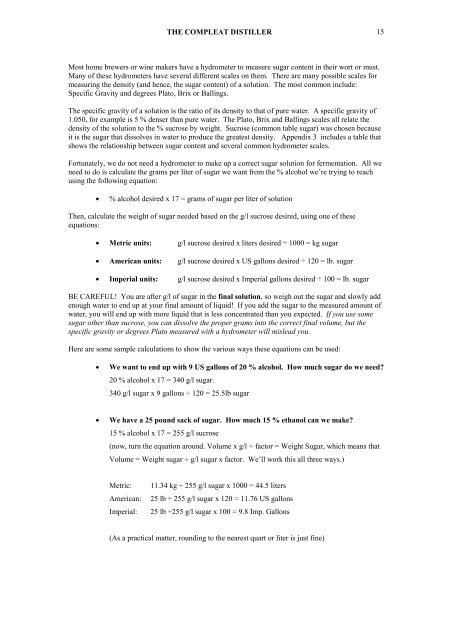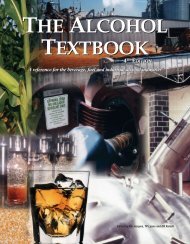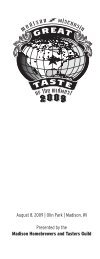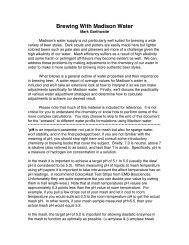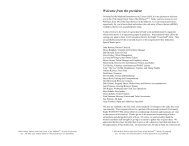The Compleat Distiller
The Compleat Distiller
The Compleat Distiller
Create successful ePaper yourself
Turn your PDF publications into a flip-book with our unique Google optimized e-Paper software.
THE COMPLEAT DISTILLER 15<br />
Most home brewers or wine makers have a hydrometer to measure sugar content in their wort or must.<br />
Many of these hydrometers have several different scales on them. <strong>The</strong>re are many possible scales for<br />
measuring the density (and hence, the sugar content) of a solution. <strong>The</strong> most common include:<br />
Specific Gravity and degrees Plato, Brix or Ballings.<br />
<strong>The</strong> specific gravity of a solution is the ratio of its density to that of pure water. A specific gravity of<br />
1.050, for example is 5 % denser than pure water. <strong>The</strong> Plato, Brix and Ballings scales all relate the<br />
density of the solution to the % sucrose by weight. Sucrose (common table sugar) was chosen because<br />
it is the sugar that dissolves in water to produce the greatest density. Appendix 3 includes a table that<br />
shows the relationship between sugar content and several common hydrometer scales.<br />
Fortunately, we do not need a hydrometer to make up a correct sugar solution for fermentation. All we<br />
need to do is calculate the grams per liter of sugar we want from the % alcohol we’re trying to reach<br />
using the following equation:<br />
• % alcohol desired x 17 = grams of sugar per liter of solution<br />
<strong>The</strong>n, calculate the weight of sugar needed based on the g/l sucrose desired, using one of these<br />
equations:<br />
• Metric units: g/l sucrose desired x liters desired ÷ 1000 = kg sugar<br />
• American units: g/l sucrose desired x US gallons desired ÷ 120 = lb. sugar<br />
• Imperial units: g/l sucrose desired x Imperial gallons desired ÷ 100 = lb. sugar<br />
BE CAREFUL! You are after g/l of sugar in the final solution, so weigh out the sugar and slowly add<br />
enough water to end up at your final amount of liquid! If you add the sugar to the measured amount of<br />
water, you will end up with more liquid that is less concentrated than you expected. If you use some<br />
sugar other than sucrose, you can dissolve the proper grams into the correct final volume, but the<br />
specific gravity or degrees Plato measured with a hydrometer will mislead you.<br />
Here are some sample calculations to show the various ways these equations can be used:<br />
• We want to end up with 9 US gallons of 20 % alcohol. How much sugar do we need?<br />
20 % alcohol x 17 = 340 g/l sugar.<br />
340 g/l sugar x 9 gallons ÷ 120 = 25.5lb sugar<br />
• We have a 25 pound sack of sugar. How much 15 % ethanol can we make?<br />
15 % alcohol x 17 = 255 g/l sucrose<br />
(now, turn the equation around. Volume x g/l ÷ factor = Weight Sugar, which means that<br />
Volume = Weight sugar ÷ g/l sugar x factor. We’ll work this all three ways.)<br />
Metric:<br />
American:<br />
Imperial:<br />
11.34 kg ÷ 255 g/l sugar x 1000 = 44.5 liters<br />
25 lb ÷ 255 g/l sugar x 120 = 11.76 US gallons<br />
25 lb ÷255 g/l sugar x 100 = 9.8 Imp. Gallons<br />
(As a practical matter, rounding to the nearest quart or liter is just fine)


